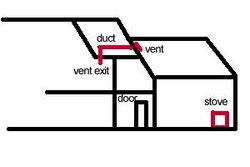I have two separate sides to my home and I want to put a wood stove in one side and figure out an efficient way to duct warm air to the other side - ideally heating both sides to some extent. The roof height of the side with the stove is a clearstory with a loft, about 20 feet tall. The side without the stove has a clearstory of 25 feet. The two connect via a single door at the first floor level. My thought is to put a vent or two high in the vaulted ceiling of the stove side and run ducts over to the non-stove side. Due to the routing of the ducts, it will have to rise in elevation and then fall into the non-vented area. I am trying to stay away from motorized fans or the like since the home is off the grid and runs on solar power (limited power), so a naturally drafted system would be best. Will this work? Is there a better way to ensure that the air amply circulates to heat the non-stove area? Thank you for your help!
Ducting heat anyone?
- Thread starter pspencer
- Start date
-
Active since 1995, Hearth.com is THE place on the internet for free information and advice about wood stoves, pellet stoves and other energy saving equipment.
We strive to provide opinions, articles, discussions and history related to Hearth Products and in a more general sense, energy issues.
We promote the EFFICIENT, RESPONSIBLE, CLEAN and SAFE use of all fuels, whether renewable or fossil.


